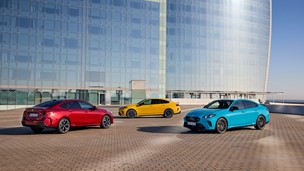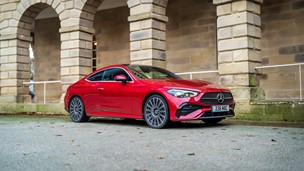To many, the Golf Plus was a mystery, dwarfed by its popular siblings, the standard Golf hatchback and Golf Estate. Their rarity on the roads made us wonder: what’s the point of this slightly taller Golf? But its relevance is more timely than ever before, with higher-positioned cars, be it crossovers or MPVs, all the rage in recent years. Competitors to the new model include the Ford C-Max, Renault Scenic and Mercedes B-Class. And its relaunch under the new name, Golf SV (an abbreviation of Sports Van), gives it a fresh breath of life, and signifies its “change of direction”, says VW. To you and me, that means the brand is trying to appeal to a younger audience as well as keep its over-55 core clientele. If there were any remaining questions about the SV’s significance in today’s car market, one only has to look at its forthcoming rival, the BMW 2-Series Active Tourer. If BMW think this segment needs addressing, there’s a good chance you’re in the right game. To give you some idea of proportions, at 4,338mm, it’s 134mm longer than the Golf Plus it replaces, 83mm longer than the Golf and 224mm shorter than the Golf Estate. Its 2,685 wheelbase is 48mm longer than the standard hatchback, inevitably making more interior space, while the SV is also 81mm wider and 126mm higher. But despite sitting between the Golf and Golf Estate for size and space, it’s more expensive than both, starting at £18,775. That’s £1,245 more than the entry-level five-door Golf and a £600 premium over the Golf Estate. It’s also more than £1,000 more than the opening price of a C-Max at £17,655 but considerably less than its luxury B-Class adversary, at £22,950. Performance 4.5/5 There’s an array of engines choices here. Two turbocharged 1.2-litre petrol engines with 84 and 109bhp; two 1.4-litre turbocharged petrol engines with 123 and 148bhp and three turbodiesels; a 2.0-litre 148bhp, a 1.6-litre 89bhp and a 1.6-litre 109bhp. Diesels are set to account for 80% of overall sales, while the latter – and most frugal engine – will be the top seller across the range. We tested the 2.0-litre 148bhp which has plenty of torque for the car, and smoothly accelerates in line with the well-mated six-speed manual ‘box. It hits 62mph in 9.2 seconds with a top speed of 131mph. The speediest variant in the range is the 1.4-litre TSI with 148bhp, achieving the benchmark sprint in 8.8 seconds. Behind the wheel, there’s little difference between the two, with just a touch more punch, unsurprisingly, in the petrol offering. But it’s certainly not enough to be a dealbreaker, especially when you consider the favourable running costs of the diesel. Ride and handling 4.5/5 It comes as no surprise that Volkswagen has nailed the driving dynamics of this car, creating well-weighted steering (that’s veering on vague but won’t appear on the radar of most buyers), a smooth ride and great refinement for driver and passengers alike. That extra height in MPVs can easily throw off the centre of gravity and generate body roll on bends and a general lack of grip on the more windy roads out there, but the SV handles itself with flair, letting you know it can be pushed with confidence by showcasing stability on rural B-roads. Refinement, even on the high-powered diesel, is also impressive. Ultimately, on-the-road, this car is so predictably good, it’s veering on the dull. But VW’s ability to emulate an easy and smooth experience behind the wheel across its model range will only continue to aid its success, here, with the Golf SV. Interior 4.5/5 The SV’s interior is everything you expect from VW. Imaginative it is not, but smart, user-friendly and well-made are all valid adjectives here, offering a quality and comfortable cabin. Trim levels echo that of the hatchback with S, SE and GT, while the BlueMotion variant is based on the S specification. All models feature Bluetooth, DAB digital radio, CD player with 5.8-inch colour touchscreen, iPod connector, air con and much more. Roof rails are also standard: black-coloured on the S and SE, and silver on the GT. The car has an array of safety systems, with an automatic post-collision braking system fitted as standard. It works by automatically braking after a collision to reduce kinetic energy and minimise the chance of a second impact. Other aids, standard from SE, include adaptive cruise control and city emergency braking. And, for the first time, the SV gets a blind spot monitor, dubbed Side Scan, which also has a so-called assistant for leaving parking spaces. This monitors the area behind and to the side of the vehicle, to help when reversing out of a parking bay. Clever stuff. Practicality 4.5/5 This car is all about practicality, That means VW has put in rear seats that slide forwards and backwards by up to 180mm, increasing either passenger or luggage space as you wish. With those seats as far back as possible, there’s 500 litres of space – 76 more than its predecessor – and sitting between the Golf at 380 litres and the Golf Estate at 605 litres. It also wins, just, against rivals, the Mercedes B-Class with 488 litres, the Ford C-Max with 471 litres and the Renault Scenic with 437 litres. Moving the rear seats forward gives you 590 litres of moving-a lot-of-stuff leeway. Running costs 4.5/5 Inevitably, the 1.6-litre 108bhp BlueMotion iteration is the most budget-friendly, offering approximate official figures of 74.3mpg and CO2 emissions of 95g/km. Then again, even the top-powered diesel, the 2.0-litre 147bhp in six-speed manual format manages a decent 115g/km CO2 and 64.2mpg. Verdict 4.5/5 The Golf SV offers everything you’d expect; all the excellence of a Golf with elevated ride height and more space. And its new looks make it prettier than the previous iteration – a hard feat to achieve in this segment. All-in-all, the car is a stronger contender than ever before. With buyers wanting a MPV for practicality and comfort, the SV is among the top in its class. It’s more practical than a C-Max, and better to drive and a fair whack cheaper than the B-Class. Now, VW just needs to make sure the model doesn’t become lost amid its ubiquitous Golf stablemates.

Our Rating



